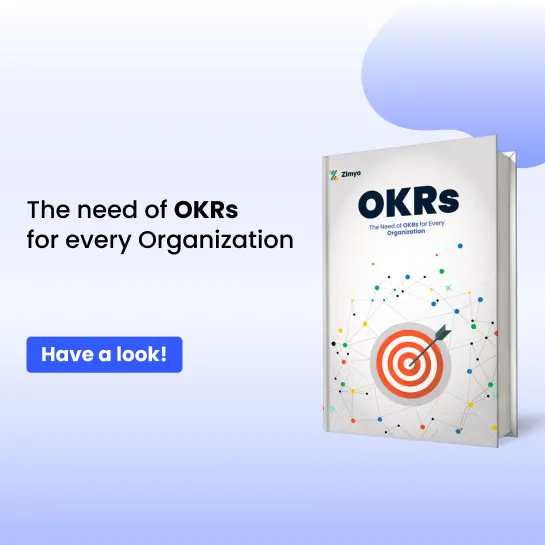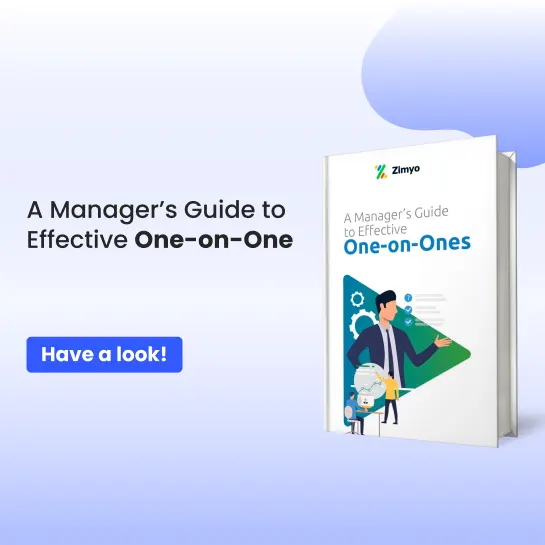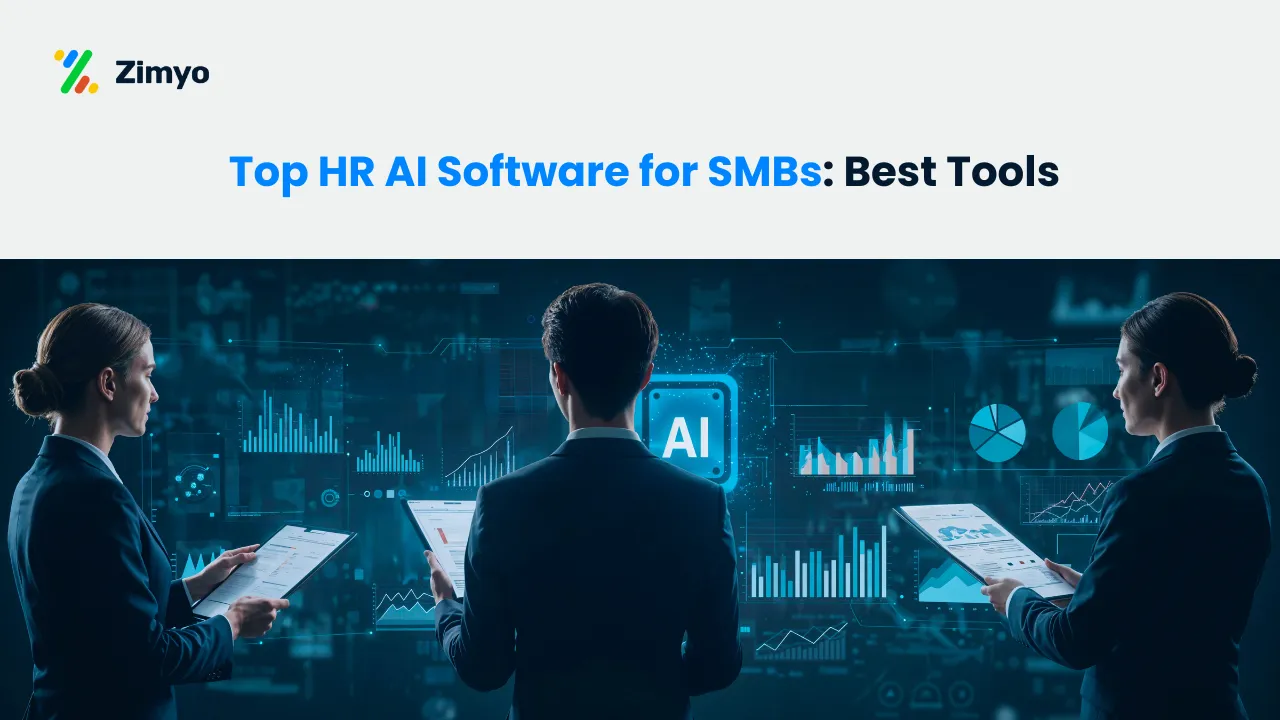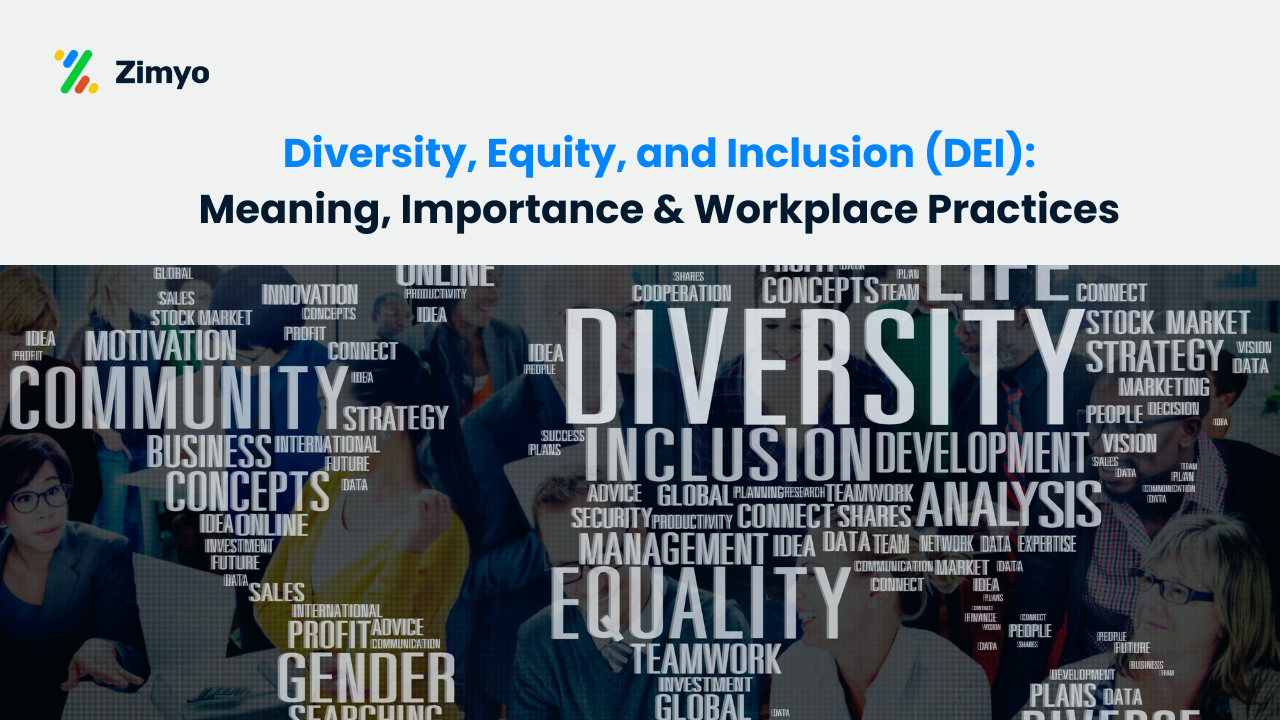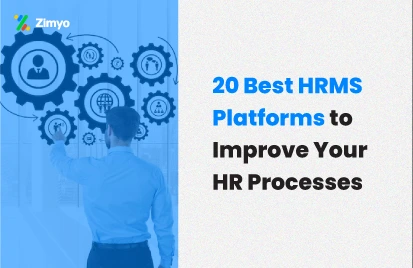One of the largest challenges for small businesses scaling is hiring. When your inbox begins to overflow with applications and your spreadsheets become unable to handle interviews, it’s time to upgrade. That’s when an Applicant Tracking System (ATS) can be just what you need.
This article investigates the Best Applicant Tracking System for Scaling Small Businesses going from all-in-one solutions to AI-based hiring tools. Whether you’re going from your first five staff to adding up a dozen teams, this listicle is here to assist you in picking the ideal solution to help you streamline and grow your recruitment process.
What Is an Applicant Tracking System?
An Applicant Tracking System (ATS)or candidate tracking system is a recruitment software solution which assists organizations in simplifying their hiring process. ATS software automates and handles the entire recruitment cycle. It aids in publishing job ads to onboard new employees.
Fundamentally, ATS software is an electronic database in which recruiters and hiring managers store, track, and manage applicant information. These tools capture everything from resume parsing, keyword filtering, and interview scheduling. Also include communications tracking with the candidate and reporting.
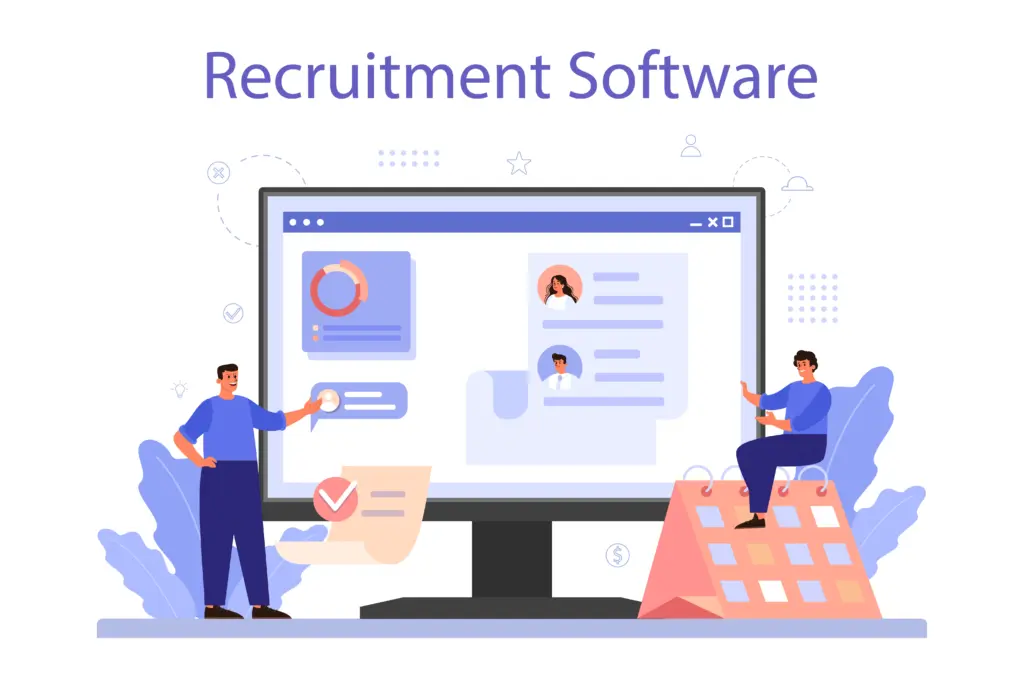
For small business owners, applicant tracking software is a saver because it reduces manual labor, minimizes the time to hire, and guarantees compliance. With the best applicant tracking system, small business owners can dedicate themselves to expanding teams without being slowed down by dull repetitive admin work.
Major Functions of an ATS:
- Posting jobs and sending them to job boards
- Collecting resumes and keyword filtering
- Interview coordination and scheduling
- Tracking candidate communication
- Collaborative feedback and scoring
- Hiring analytics and reporting
Whether scaling a startup or optimizing an expanding HR function, the best applicant tracking system can enable you to attract, engage, and hire the right talent more effectively.
Check Out Our ATS Guide For Recruiters.
List of Top 12 Best Applicant Tracking System
1. Zimyo
2. Greenhouse
3. BambooHR
4. Zoho Recruit
5. Workable
6. Breezy HR
7. JazzHR
8. Manatal
9. Recruit CRM
10. Recruitee
11. Bullhorn
12. Lever
Best Applicant Tracking Systems for Scaling Small Businesses: In Deatil
Recruitment is the most essential task for any expanding business. But as your staff grows, managing spreadsheets, emails, and stacks of resumes won’t be enough. Meet the candidate Tracking System – that centralizes, simplifies, and expands the hiring process.
Below, we’ve compiled the most powerful and user-friendly best ATS systems tools designed to the needs of small businesses and startups aiming to grow fast without compromising on talent quality.
Zimyo is an emerging star in the Indian HR technology space, providing a comprehensive HRMS with a robust ATS designed exclusively for small and medium enterprises. It’s not only an applicant tracking solution, Zimyo designs a smooth recruitment-to-onboarding experience and also manages HR functions such as payroll, leave, attendance, and performance management. For small enterprises that want to prevent managing separate tools, Zimyo provides a unified ecosystem to manage the entire employee journey. Therefore, this tool could be considered on top for Best Applicant Tracking Systems for Scaling Small Businesses.
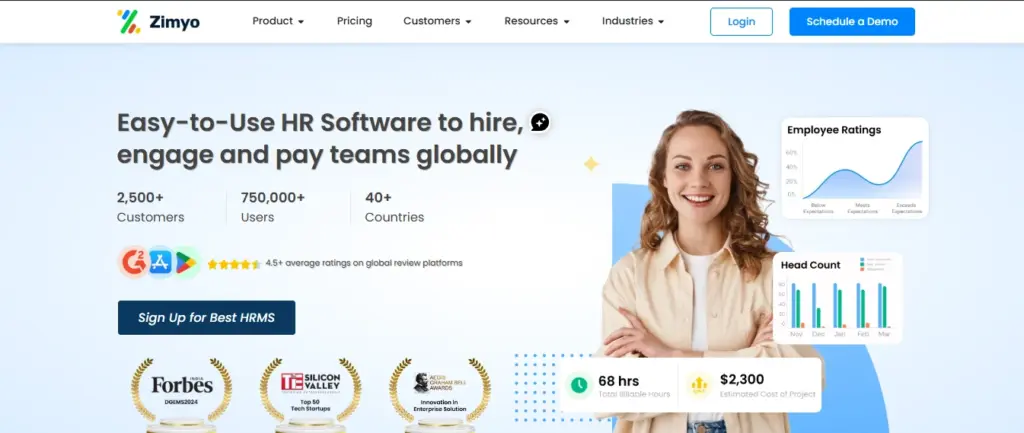
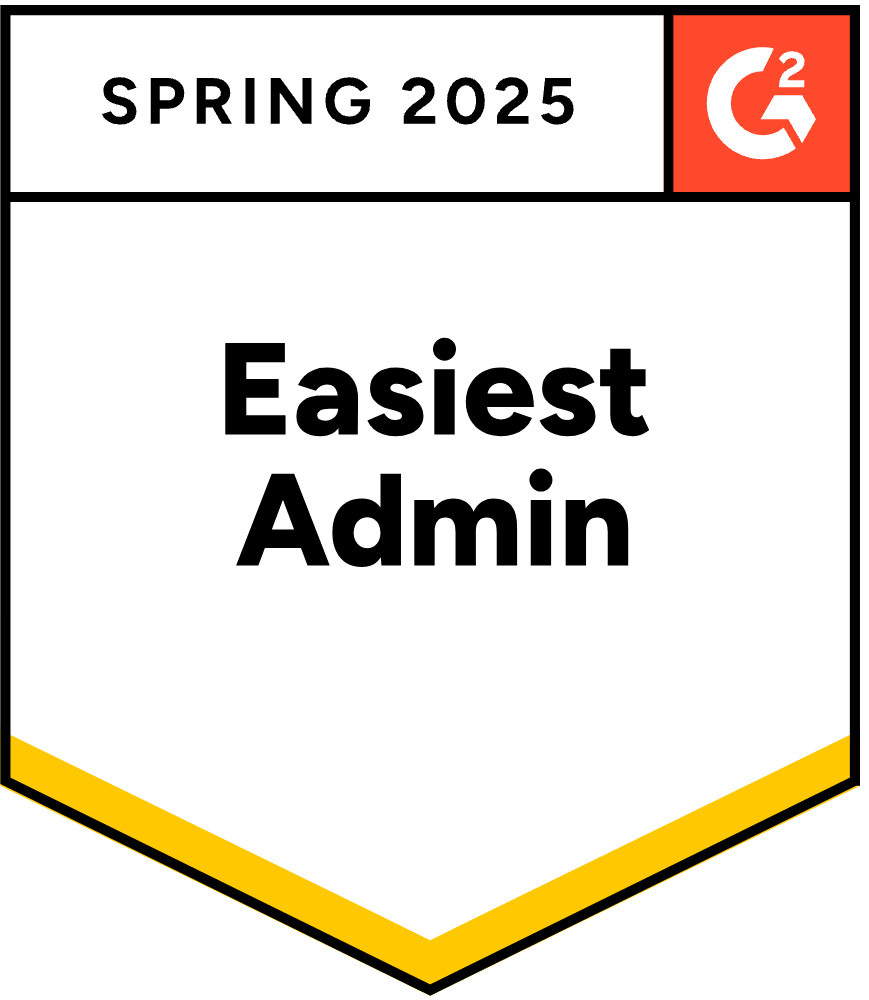
Check Zimyo’s ATS.
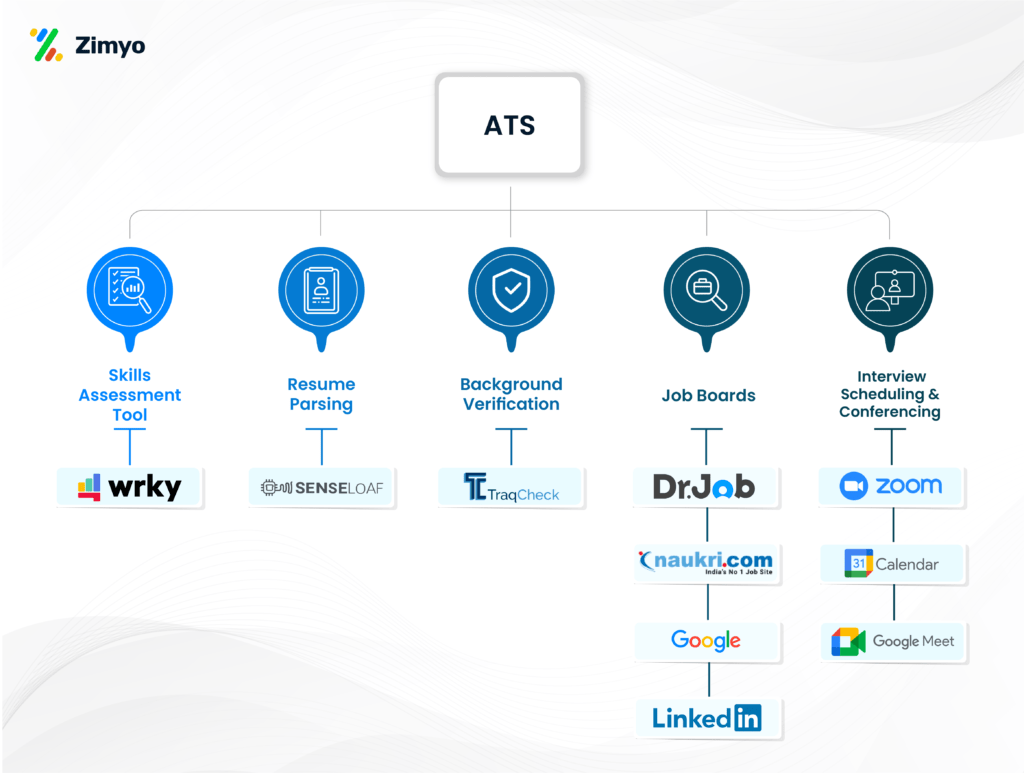
Key Features:
- Multi-channel job posting with one click
- AI-enabled resume parsing and smart candidate filtering
- Interview feedback loops and collaboration tools
- Instant offer letter generation and digital onboarding
Pros:
- Budget-friendly pricing for growing companies
- Localized compliance features (ideal for Indian market)
- Offers a complete HRMS + Payroll + ATS suite
Cons:
- Currently limited third-party ATS integrations
- Advanced recruiting analytics still in progress
2. Greenhouse
Greenhouse is an internationally recognized recruitment tool for building a consistent, unbiased, and data-informed hiring experience. Built for scale, Greenhouse allows businesses to construct structured hiring processes from day one fully intact with interview kits, scorecards, and DEI tools. Although it might have more than smaller companies need at first, those planning on speedy growth will find enormous value in the long run.

Key Features:
- Structured interview kits with scorecards
- Custom hiring processes and approval processes
- Strong Talent CRM and DEI-driven hiring
- Data-driven analytics and pipeline reports
Pros:
- Strong customization and scalability
- Deep integration ecosystem with more than 300 apps
- Industry-leading candidate experience tools
Cons:
- Can be daunting to set up at first
- Premium plans are expensive for small teams
3. BambooHR
BambooHR has its reputation for being an easy HR platform to use. Although it’s not specifically an ATS but it does have a simple, straightforward applicant tracking module integrated into its core HR offering. For companies wanting to boost HR and hiring without cumbersome tools, BambooHR offers an uncluttered and smooth experience that gets the job done on the basics.

Features:
- Customized job postings and application tracking
- Pre-designed offer letters and eSignatures
- Automated onboarding checklists
Pros:
- Extremely user-friendly interface
- Seamless integration between ATS and core HR functions
- Ideal for early-stage businesses
Cons:
- Limited job sourcing or AI matching tools
- Not suitable for companies with complex hiring needs
4. Zoho Recruit
A part of the larger Zoho suite, Zoho Recruit is an affordable and flexible ATS catering to corporate HR departments as well as recruitment agencies. It excels in automation, resume management, and pipeline tracking. Whether posting jobs on several portals or auto-emailing applicants, Zoho makes recruiting easier.
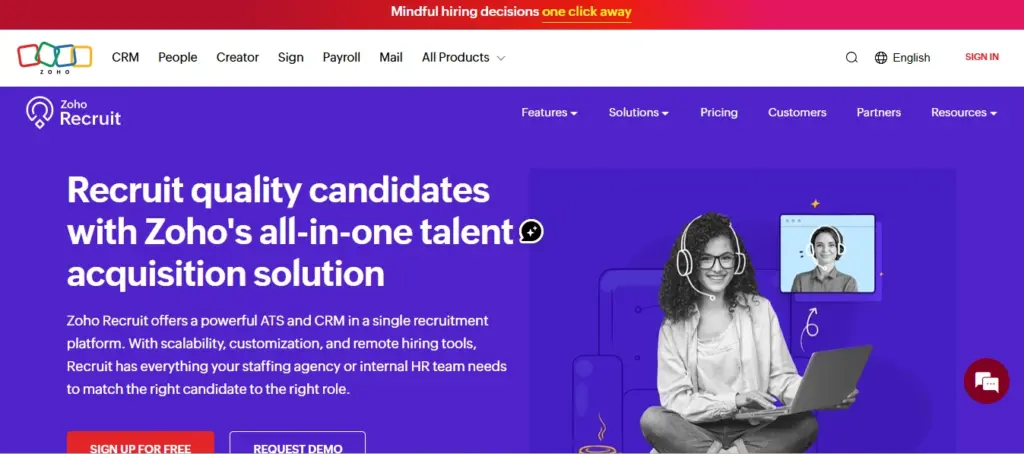
Key Features:
- AI-driven resume parsing
- Automating candidate scoring and job matching
- Branded career pages and job portal management
- Workflow triggers for auto-emails and tasks
Pros:
- Affordable with solid features
- Smooth integration with other Zoho apps
- Flexible for external and internal recruiters
Cons:
- User interface is outdated
- Some bugs and performance issues from time to time
5. Workable
Workable marries ease of use with innovative sourcing features. Its AI-powered features streamline candidate identification and matching, suited for fast-growing lean teams. With integration of remote hiring, scheduling of interviews, and video interviewing, Workable is a contemporary solution for progressive businesses.
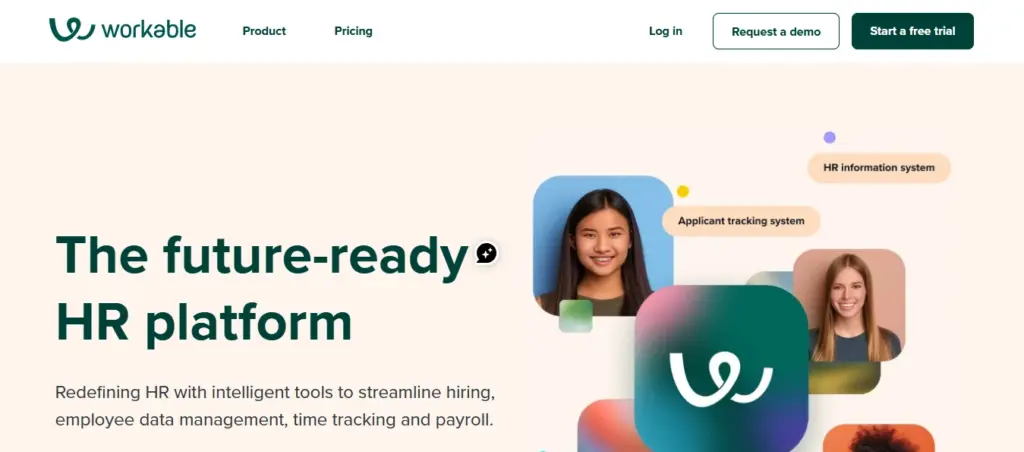
Key Features:
- AI-powered candidate suggestions
- Job posting on 200+ job boards automatically
- Video interview and scheduling tools integrated
- E-signature and document management
Pros:
- Visually friendly and simple to use
- Powerful candidate sourcing capabilities
- Solid mobile and remote hiring features
Cons:
- Premium features become costly
- Less flexibility in lower-tier plans
6. Breezy HR
Breezy HR is built to be simple. Through visual hiring pipelines, it lets its users drag-drop applicants through recruitment stages. For smaller teams that are just getting started on recruiting or have fewer recruiting resources, Breezy HR offers automation, branded career websites, and collaboration features so easy to use.

Primary Features:
- Visual pipeline with drag-and-drop interface
- Branded careers page builder
- Email and workflow automation
- Interview guides with rating scorecards
Pros:
- Intuitive and easy to use for beginners
- Excellent candidate experience attributes
- Fast deployment
Cons:
- Limited analytics and reporting
- Not suitable for agencies or high-volume recruiting
7. JazzHR
JazzHR is designed from the ground up for small business. It introduces enterprise-level recruiting features to small teams without an enterprise-level price tag. With unlimited job postings, customizable workflows, and streamlined interview management, JazzHR is a sound choice for SMBs just starting to formalize the hiring process.
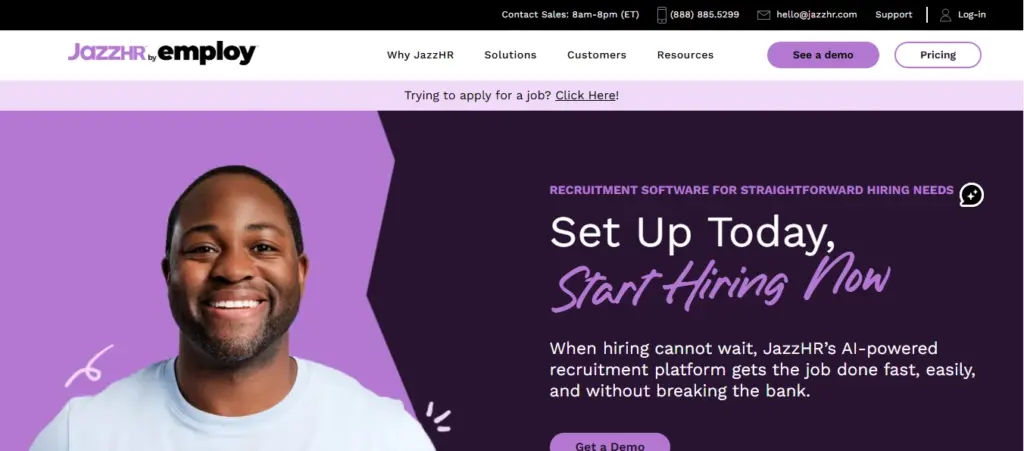
Key Features:
- Customizable job and interview workflows
- Scorecards and evaluation templates
- Unlimited job listings on free and premium boards
Pros:
- Affordable and clear pricing
- Designed specifically for SMBs
- Very heavy focus on hiring collaboration
Cons:
- No mobile app
- Does not have deeper analytics and integrations
8. Manatal
Manatal integrates artificial intelligence into recruitment, providing candidate suggestions, enriched profiles, and social media sourcing. Ideal for SMBs who want to move away from conventional hiring methodologies. Manatal makes more data-driven decisions with less manual intervention.
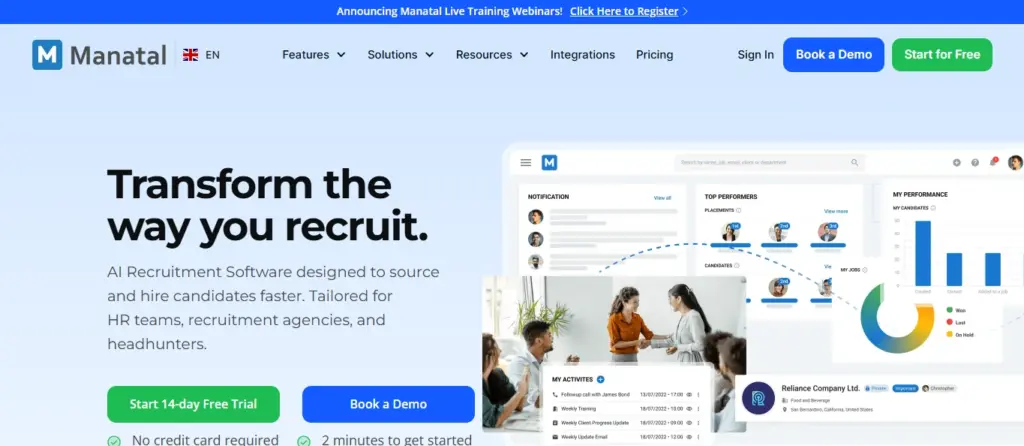
Key Features:
- Candidate scoring and matching based on AI
- LinkedIn and social enrichment of profiles
- Drag-and-drop interface customizable pipelines
- Integrated CRM for candidate relationship management
Pros
- Visually simple and clean
- High-end sourcing features
- Competitive pricing
Cons:
- Third-party integrations are basic
- Reporting and export functionality are limited
9. Recruit CRM
Recruit CRM is specifically designed for agency recruiters requiring an ATS and a CRM in one tool. It features client management, email sequences, and end-to-end recruitment workflows from sourcing to placement to client reporting.
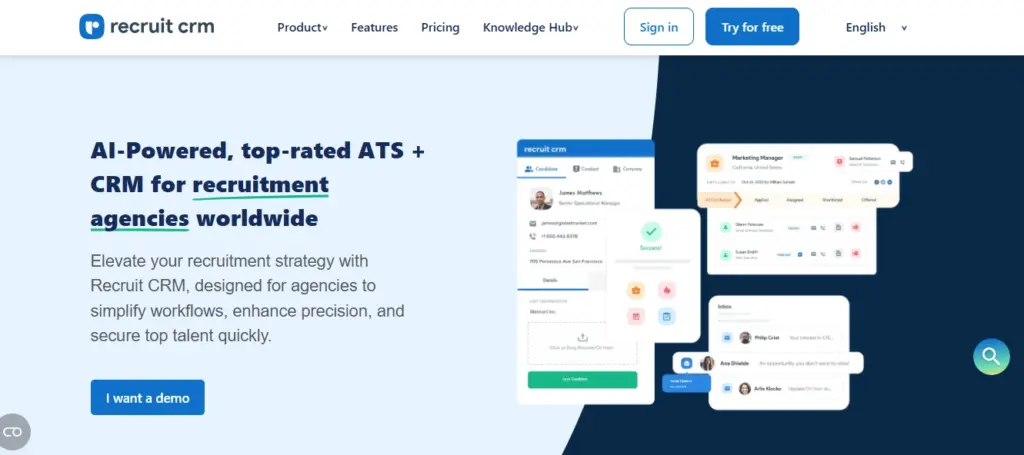
Key Features:
- Kanban boards and pipelines that can be customized
- Resume gathering from job boards and databases
- Client and candidate portals
- Invoicing and placement tracking functionality
Pros:
- Developed specifically for recruitment agencies
- Transparent price with worldwide support
- Client + candidate management in one
Cons:
- Not suitable for in-house HR teams
- Needs some training to get maximum value
10. Recruitee
Recruitee focuses on collaborative hiring, making it easy for HR teams and hiring managers to work together at scale. With customizable workflows, team scorecards, and automated emails, Recruitee keeps hiring organized and inclusive.
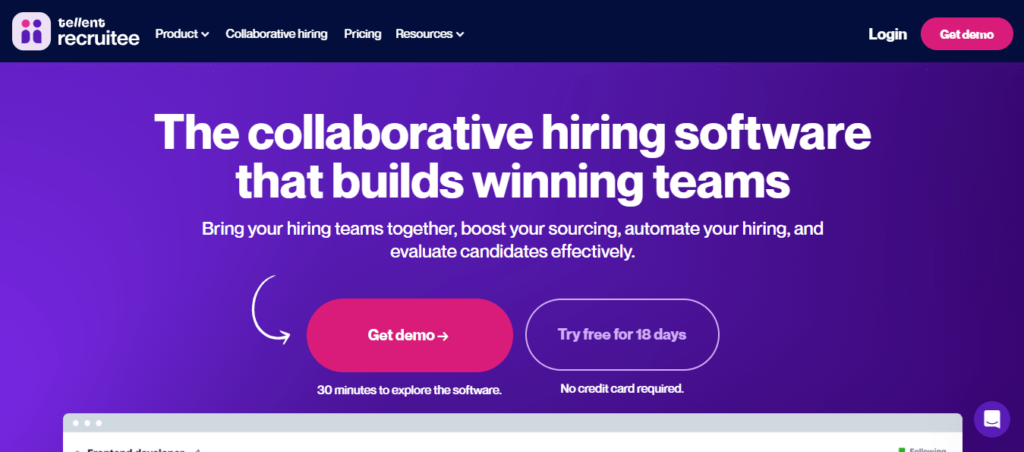
Key Features:
- Branded career site builder
- Collaborative scorecards and interview evaluations
- Email templates and automation workflows
- Role-based access for hiring teams
Pros:
- Easy for non-HR users to adopt
- Scales well with growing teams
- Good UX and team communication features
Cons:
- CRM capabilities are limited
- Fewer sourcing functionalities than others
11. Bullhorn
Bullhorn is a full-service ATS + CRM solution utilized by some of the world’s largest staffing agencies. It provides support for large-scale recruitment operations through automation, mass communication, performance tracking, and compliance management.
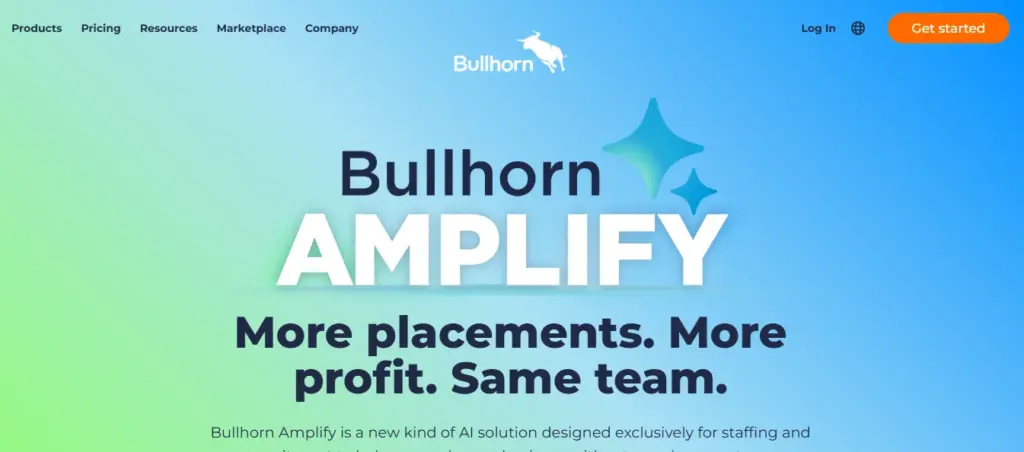
Key Features:
- Email automation and mass outreach campaigns
- Talent pipeline monitoring and reporting
- Custom dashboards and KPIs
- VMS integration and billing platforms
Pros:
- Vast functionality for enterprises and agencies
- Excellent third-party integration system
- Does it all from sourcing to placement
Cons:
- Expensive cost and challenging implementation
- Overkill for the majority of small businesses
12. Lever
Lever marries ATS and CRM to enable not only hiring, but to foster long-term talent relationships. With functionalities such as DEI reporting, candidate pipeline nurture, and automated engagement campaigns, Lever is ideal for firms with strategic hiring objectives.
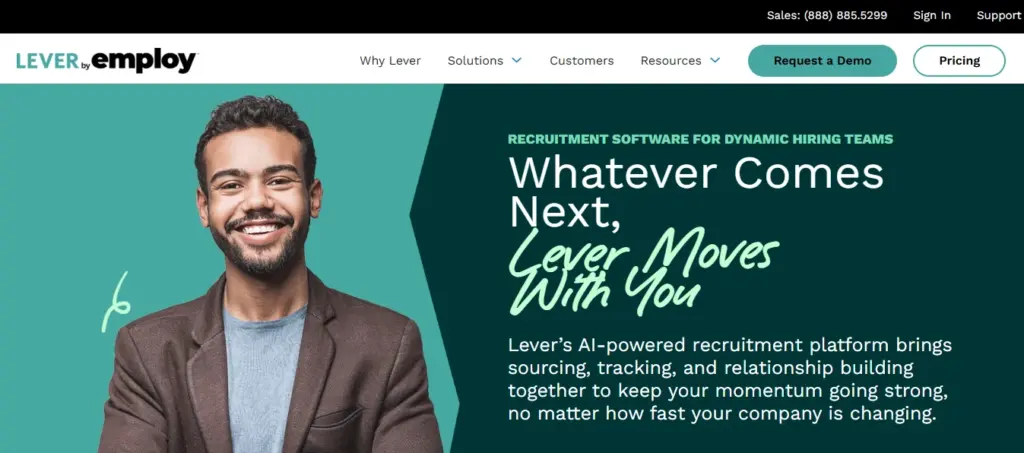
Key Features:
- Custom pipelines and stage tracking
- Passive talent automation campaigns
- DEI insights and diversity analytics
- Integrated sourcing and referral programs
Pros:
- Rich analytics and visual dashboards
- Top-notch for proactive, data-driven recruiting
- Top-shelf candidate experience
Cons:
- Long, complex UI for small teams
- Premium pricing might not be ideal for startups
I was able to implement the platform on my own. It helps in assigning the tasks to other employees, conducting surveys and polls, and much more. The ease of use and self-onboarding is something that I would like to appreciate.
Sonali, Kommunicate
Zimyo simplifies attendance management for our organization. The leave and attendance are so streamlined that we have never faced any difficulties with the system.
Anurag, Eggoz Nutrition
Must-Have Features in an ATS for Small Businesses
Selecting an ATS requires more than just checking boxes. It’s about making sure the platform serves your business’s unique hiring needs today and grows with you tomorrow. Here are the must-have features to keep an eye out for:
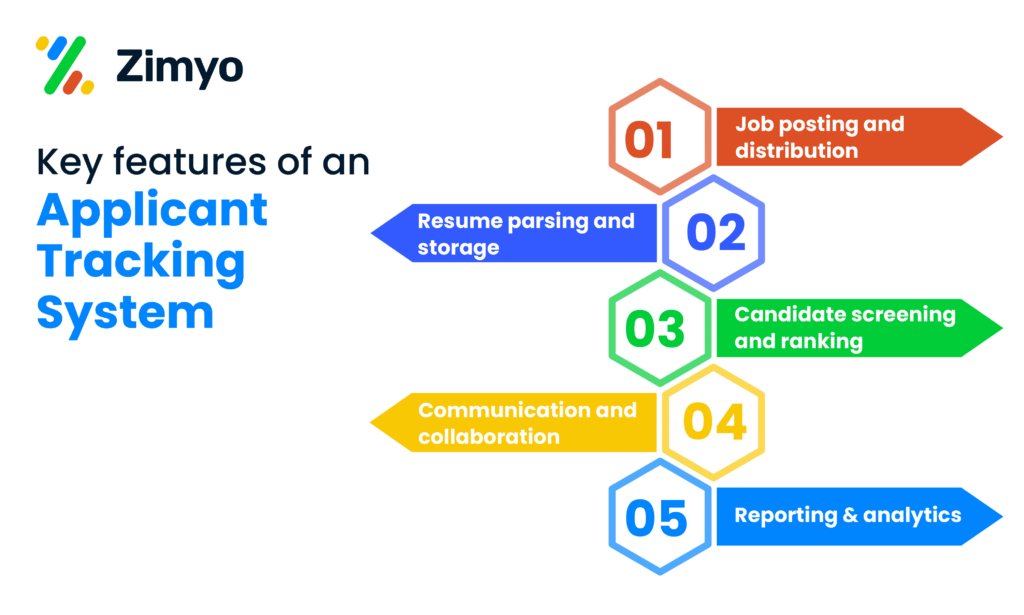
Resume Parsing
Automates the import of candidate information from resumes, eliminating hours of manual entry and allowing for rapid filtering by skills, experience, or keywords.
Custom Workflows
Each business processes hiring slightly differently. Check for an ATS software which supports customized workflows with particular interview steps, approvals, and notifications.
Job Board Integrations
Reach more potential candidates with a one-click posting of jobs to multiple boards such as LinkedIn, Indeed, Glassdoor, Naukri, and more – all within your candidate tracking system.
Interview Scheduling
Avoid the email ping-pong with calendar-integrated tools. Search for Google Calendar or Outlook integration and automated reminders.
Team Collaboration
Enable hiring managers, recruiters, and team members to provide comments, rate candidates, and leave feedback in one location. Scorecards and interviewer notes are essential features.
Automated Communication
Engage with candidates consistently using automatically generated emails, notifications, and reminders. This encompasses confirmations, rejections, and interview invitations.
Career Site Builder
Recruit best talent with a custom careers page showcasing your employer brand. This also minimizes third-party portal dependence.
Reports & Analytics
Monitor time-to-hire, source of applications, stage conversions, and recruiter performance. Insights based on data optimize hiring strategies and minimize bottlenecks.
Best ATS systems provide these capabilities in an easy-to-use interface that allows your team to learn with ease because excellent hiring shouldn’t have a learning curve.
Pricing & Costs for Applicant Tracking Systems
Applicant Tracking Systems (ATS) has a range of different pricing plans to suit various business sizes and recruitment needs. There is a simple free plan best for startups and small groups right up to sophisticated, fully-featured solutions designed for large businesses.Knowing these pricing models is important to selecting a solution that suits both your recruitment requirements and cost.
Typically, ATS costs between $10 and $100 per user, per month, though some software will charge a monthly, fixed fee instead. Some providers also tack on one-off implementation or setup charges.
The good news? Most sellers provide a free trial or demo, allowing you to test out the capabilities of the platform before committing financially.
How to Choose the Right ATS (Step-by-Step Guide)
Selecting the ideal applicant tracking system for your small business is not a cookie-cutter situation. It calls for a systematic assessment of your business requirements, existing recruitment process, budgetary limitations, and future business expansion strategies. Below is a step-by-step guide to enable you to make a wise, expandable decision:
1. Assess Your Recruitment Volume
Understand how many positions you usually recruit for in a month or quarter. If your company hires very often for several positions or executes seasonal hiring campaigns, you’ll require a candidate tracking software with automation, bulk resume management, and candidate pipeline management.
2. Determine a Realistic Budget
Small firms need to weigh functionality over affordability. Seek out the best ATS systems that have flexible pricing plans, pay-as-you-grow systems, or freemium models with essential features. Be upfront about your budget so you won’t have to pay for extra add-ons down the road.
3. Determine Must-Have Features
Make a list of must-have features that your hiring team requires. These could be resume parsing, collaboration tools for teams, interview scheduling, or reporting dashboards. Order of priority should be functionality to address your current pain points.
4. Make Seamless Integrations
Your ATS must coexist comfortably with current tools such as your HRIS system, calendar applications (Google or Outlook), email platforms, or background check services. Integration saves work and keeps data in sync.
5. Use Demo or Free Trial
Don’t buy without trying. A demo or free trial is provided by most ATS vendors. Take advantage of it to check out the interface, mimic actual hiring workflows, and see how user-friendly and tunable the system is. Get feedback from your hiring staff as well.
6. Customer Support Inquiry
Responsive customer support is always a time-saver during onboarding or technical problems. Inquire if the vendor offers live chat, email, or phone support and read real user feedback on response times and resolution effectiveness.
7. Think about Scalability & Flexibility
Your hiring requirements will change. Select an ATS that will grow with your staff, handle multiple positions or departments, and permit feature upgrades without requiring a system change. Look to the future – will this platform still be beneficial to your staff 2–5 years down the road?
8. Check Data Security & Compliance
Particularly if you work with sensitive candidate information, ensure the ATS is GDPR or SOC 2 compliant. A secure platform maintains candidate trust and organizational integrity.
Using this checklist as guiding source, you can reliably shortlist the Best Applicant Tracking System for Scaling Small Businesses that supports your business goals, technical requirements, and hiring procedures.
Benefits of Using Best Applicant Tracking System for Scaling Small Businesses
Investing in the top applicant tracking system is a strategic investment that can significantly boost hiring results especially for emerging companies. Here’s why small businesses succeed with an applicant tracking software:
1. Accelerated Hiring
Automated workflows, resume parsing, and scheduling tools streamline every recruitment stage. This dramatically reduces time-to-hire, allowing you to land top talent before other companies do.
2. Improved Collaboration
An ATS enables HR managers, recruiters, and department heads to collaborate in unison. Collaborate on candidate profiles, add comments, rate candidates, and follow communication, all from one location.
3. Centralized Candidate Data
Eliminate the jumbled spreadsheets and email threads. With a centralized database, you can keep resumes, communication history, interview notes, and hiring status all within one secure system.
4. Improved Candidate Experience
On-time responses, auto-updates, and regular communication create a good experience for applicants whether they are hired or not. This improves your employer brand.
5. Fewer Errors & Manual Processes
An ATS reduces the chances of human error through auto-updating application status, sending reminders, and automating repetitive tasks such as sending emails or scheduling interviews.
6. Employer Branding
Current ATS solutions include feature-rich career page creators and branded email templates. These features enable you to display a professional and uniform brand image to all candidates.
7. Enhanced Reporting & Analytics
Monitor critical metrics such as time-to-hire, source of hire, candidate drop-off rates, etc. Live reports allow you to identify inefficiencies and make data-driven hiring decisions.
8. Cost-Effective Scaling
As your hiring requirements expand, an applicant tracking software a allows you to grow operations without significantly boosting workload or headcount. Most systems provide modular upgrades to keep pace with your growth rate.
In brief, applicant tracking software is not only for large companies, instead it’s a necessary hiring partner for small business owners looking to grow quickly, professionally, and cost-effectively.
Final Thoughts
Investing in the right ATS isn’t just about hiring faster, it’s about hiring better. From feature-rich platforms like Greenhouse and Lever, to startup-friendly options like Zimyo and Zoho Recruit, there’s a solution tailored for every growing business, and with our research that’s also made easy.
If you’re looking for an affordable, all-in-one HR + ATS solution with exceptional customer support and features like payroll and performance management – Zimyo is a great place to start. Finally selecting the ideal ATS is your initial step toward constructing a future-proof recruiting engine. Don’t rush, test demos, and match the tool to your long-term growth objectives.
FAQs
What is the applicant tracking system?
An Applicant Tracking System (ATS) is software that helps businesses manage their hiring process by automating tasks like resume screening, job posting, interview scheduling, and candidate communication.
Which is the most popular ATS?
Popular ATS platforms include Zimyo, Greenhouse, Lever, BambooHR, and Workable. The best applicant tracking system for you depends on your company size, industry, and hiring needs.
What is ATS used for in HR?
In HR, an ATS is used for candidate tracking, resume management, interview coordination, team collaboration, and data-driven hiring decisions, all from a single platform.
Is ATS a type of CRM?
No, an ATS is not a CRM. An ATS manages the hiring process, while a CRM handles customer relationships. However, some recruitment tools offer CRM-like features to manage candidate relationships.
What is an ATS-approved HR resume?
An ATS-approved HR resume is formatted to be easily read by applicant tracking systems. It uses simple layouts, standard fonts, keyword-rich content, and avoids tables, images, or graphics that ATS software may not parse correctly

